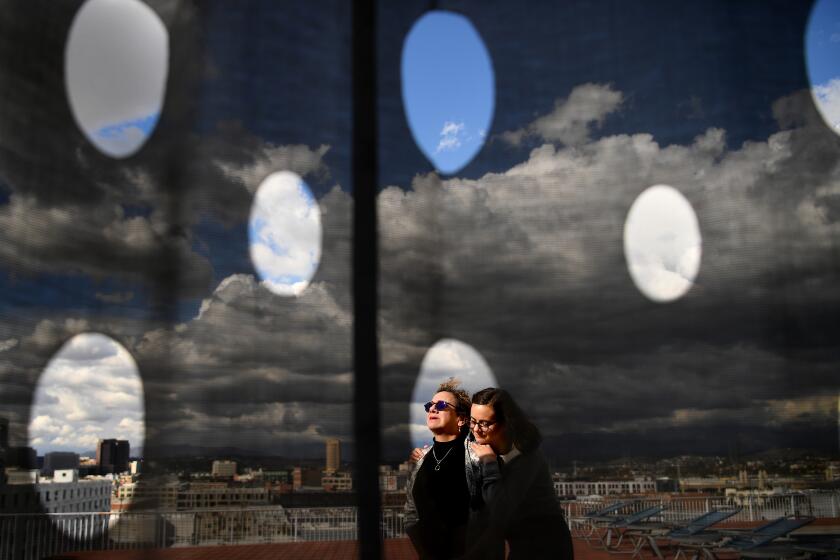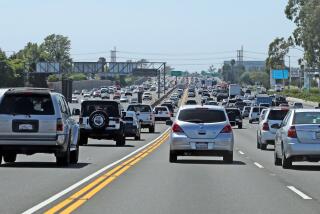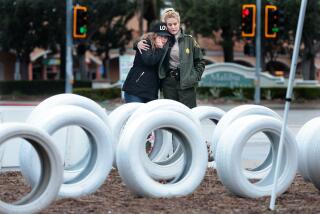Column: Speeding in L.A.? Soon, you might be on camera, with a ticket in the mail
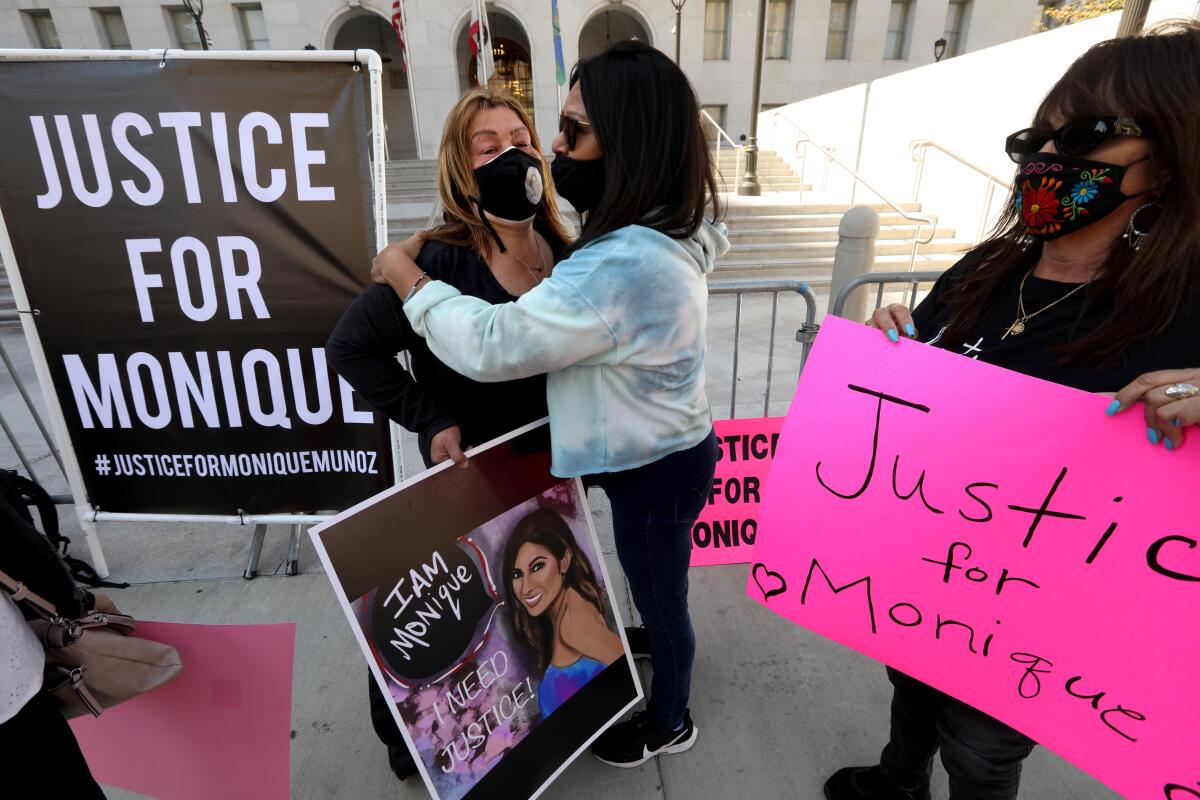
- Share via
Jenny Yu of San Francisco broke down Tuesday morning when she talked about the day 10 years ago when her mother went for a stroll and was clobbered, in a crosswalk, by a speeding driver.
“Everything that defined her daily life and happiness ended in that moment,” said Yu, of Families for Safe Streets. “In that moment, that speeding driver left my vibrant 62-year-old mom with a ruptured spleen, fractured ribs and a fractured humerus … and also left … a mother, a grandmother and wage earner with other injuries that will never heal.”
Gina LeBlanc of San Jose was next up as a speaker at a news conference held by state Assemblyman David Chiu (D-San Francisco), who on Tuesday introduced legislation calling for automated speed enforcement. LeBlanc held up a photo of a smiling, curly haired young man.
“This is my son Kyle,” LeBlanc said of the 18-year-old high school student, who was hit by a car while crossing a street on foot in 2016. He “is no longer here because of a preventable crash. … Unsafe speed killed my son.”
There have been fewer cars on streets and highways this last year, but more reckless driving and speeding. Two grieving families know the grim statistics all too well.
On Sunday, when I wrote about the perils of drivers thinking that light traffic during the pandemic is a license to try out for NASCAR, readers shared their own horror stories about speeding drivers and offered their own solutions. One was automated speed enforcement, which I’d already been looking into.
The way it works is that, if you’re driving over the speed limit in a monitored area, a sensor will read your speed and license plate, and you’ll get a citation in the mail.
Currently, the technology is prohibited in California, but 140 communities in the country have used it with impressive results.
“Washington, D.C., saw a 70% reduction in speeding,” said Seleta Reynolds, general manager of L.A.’s Department of Transportation. “New York saw huge reductions in severe and fatal crashes. That technology is going to save people’s lives for years to come.”
And now two speed-enforcement bills under consideration in the state Legislature would legalize use of the technology in California.
Chiu’s bill, AB 550, would authorize speed detection on streets identified as dangerous and in work zones, and the bill calls on the state transportation agency to work with local government to administer the program.
A bill by state Sen. Susan Rubio (D-Baldwin Park), SB 735, would authorize local communities to set up automated speed enforcement around schools. Rubio, a former teacher, told me her bill is something she’s thought was needed for years, especially after a student was struck and killed outside a school she worked at in Baldwin Park.
“As a vice principal for three years, my job … at times was to manage traffic,” Rubio said. “People are trying to drop off their kids as cars are speeding through.”
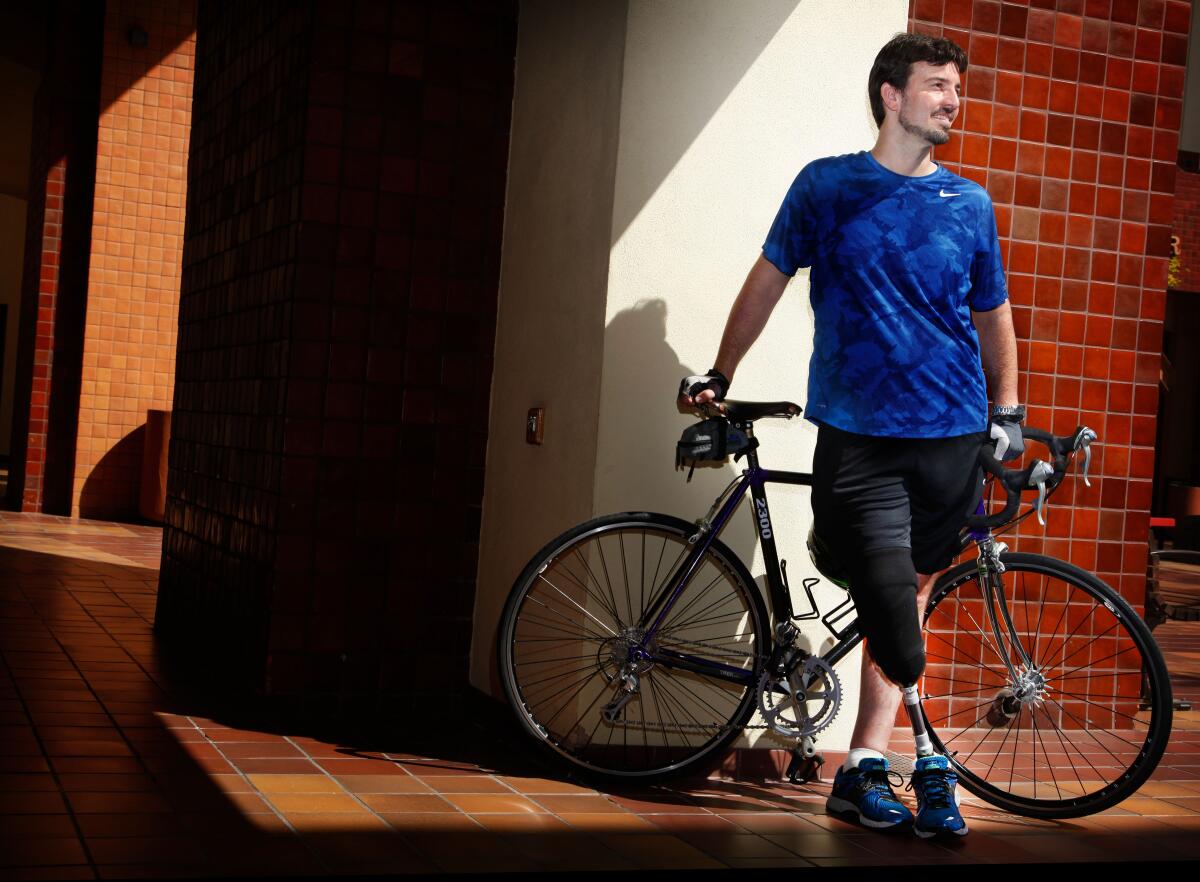
Damian Kevitt is executive director of Streets Are for Everyone, which has worked with Rubio on her bill, and he says other states have used this tool to great success.
“It reduced speeding and traffic collisions and fatalities,” Kevitt said. “Statistically speaking, kids and the elderly are the most vulnerable.”
The idea, Kevitt said, isn’t to blindside drivers or impose punitive fines, and the penalties would be civil rather than criminal. It’s to get drivers thinking about unsafe speeds and the inherent danger. The bill “requires very obvious signage indicating that you are entering a speed safety zone. You can’t set up a trap.”
Kevitt said Rubio’s bill would impose fines of up to $150 but include a scale for lesser fines based on ability to pay. Chiu’s bill would also have that element, capping fines at $125. Chiu tried similar legislation in 2017 and didn’t get anywhere with it, but said he thinks the success of automated enforcement in other cities is one factor that should help this time.
Kevitt said opposition to such proposals has come from police unions in the past because they fear job losses with automated enforcement. But Kevitt said that hasn’t been the case in other jurisdictions, and both Rubio and Chiu told me they think freeing some police officers from speed enforcement would allow them to focus on other duties.
Giving this a try seems like a no-brainer to me. Los Angeles averages about 250 auto-collision fatalities a year, some of which involve distracted driving, driving under the influence or other factors besides speed. But as I said in my previous column, it feels like crazy drivers are everywhere lately, putting other people at risk but seldom paying a price. And that’s true, of course, even when there’s not a pandemic.
But there’s almost sure to be some opposition to automated speed cops on civil liberties grounds, as there was during the red-light camera debacle in Los Angeles. Beginning in 2004, the registered owners of cars that were detected blowing through red lights or making illegal turns got tickets in the mail, but some argued that they weren’t driving at the time, and 40% of the recipients didn’t bother to pay.
The courts weren’t aggressively committed to doing anything about it, especially after city officials determined that for various reasons, legal and otherwise, payment of such fines was essentially voluntary. At that point, those who had paid their fines were ticked off, and in 2011, the whole program was ditched in a unanimous vote by L.A. City Council.
But past incompetence is no reason to derail legislation that appears to be proceeding with the full benefit of lessons learned, and safeguards against bad policy or implementation. Especially given the fact that so many people are injured or killed because of speeding.
L.A.’s transportation manager Reynolds said Chiu’s bill lays out a plan for carefully designing pilots customized to each community’s needs and addressing issues of equitable enforcement, ability to pay and personal privacy.
“The public’s acceptance of these kinds of technologies is going to move at the speed of trust, so having that process built in at the front end is a really valuable step,” said Reynolds.
It remains to be seen what such systems will cost, but Reynolds said that ideally, there’d be enough revenue to pay for the equipment and management, if not have something leftover to help finance the ongoing redesign of streets to make them safer for vehicles, cyclists and pedestrians.
If it’s successful, though, revenues will decline as people learn that speeding can nick your wallet. Several years ago, after returning from a trip to Italy, I got a ticket in the mail for speeding outside Venice, even though I had no idea I was exceeding the speed limit or that anyone was watching. The fine from the automated enforcement system was enough of a pinch that if I’m ever driving in Italy again, I’m going to watch the speed needle.
At Chiu’s news conference, Oakland Mayor Libby Schaaf said just in the last year, three mothers were killed while walking in crosswalks near schools. San Francisco Mayor London Breed called dangerous driving “a public health hazard,” and San Jose Mayor Sam Liccardo joined the chorus in supporting speed enforcement.
Chiu told me that every year, he attends a memorial service for constituents killed in auto collisions. California averages thousands such fatalities each year, and countless more have been injured.
“We know speed kills,” Chiu said. “We have the tools right in front of us to stop these deaths.”
More to Read
Sign up for Essential California
The most important California stories and recommendations in your inbox every morning.
You may occasionally receive promotional content from the Los Angeles Times.

